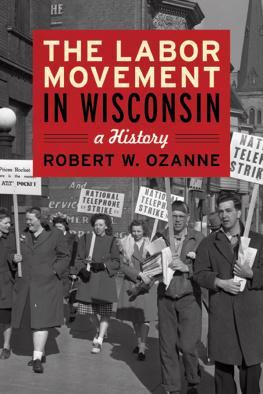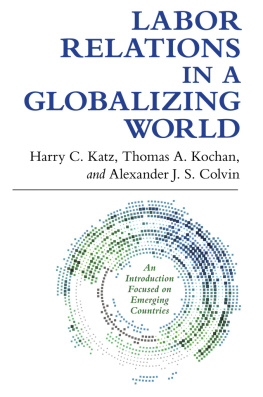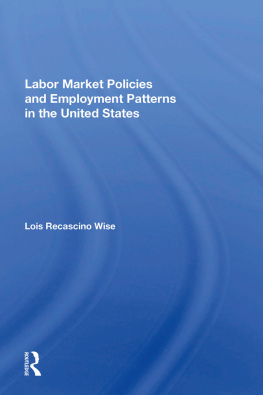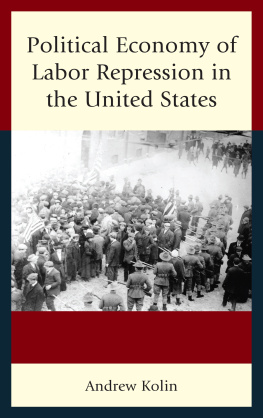ROUTLEDGE LIBRARY EDITIONS:
THE LABOUR MOVEMENT
Volume 28
THE POLITICAL DIMENSION
OF LABOR-MANAGEMENT
RELATIONS
THE POLITICAL DIMENSION
OF LABOR-MANAGEMENT
RELATIONS
National Trends and State Level
Developments in Massachusetts
(Volume 2)
PHILLIP SAUNDERS
First published in 1986 by Garland Publishing, Inc.
This edition first published in 2019
by Routledge
2 Park Square, Milton Park, Abingdon, Oxon OX14 4RN
and by Routledge
711 Third Avenue, New York, NY 10017
Routledge is an imprint of the Taylor & Francis Group, an informa business
1986 Phillip Saunders
All rights reserved. No part of this book may be reprinted or reproduced or utilised in any form or by any electronic, mechanical, or other means, now known or hereafter invented, including photocopying and recording, or in any information storage or retrieval system, without permission in writing from the publishers.
Trademark notice: Product or corporate names may be trademarks or registered trademarks, and are used only for identification and explanation without intent to infringe.
British Library Cataloguing in Publication Data
A catalogue record for this book is available from the British Library
ISBN: 9781138324350 (Set)
ISBN: 9780429434433 (Set) (ebk)
ISBN: 9781138352445 (Volume 28) (hbk)
ISBN: 9780429434747 (Volume 28) (ebk)
Publishers Note
The publisher has gone to great lengths to ensure the quality of this reprint but points out that some imperfections in the original copies may be apparent.
Disclaimer
The publisher has made every effort to trace copyright holders and would welcome correspondence from those they have been unable to trace.
| POLITICAL |
| DIMENSION OF |
| LABOR-MANAGEMENT |
| RELATIONS | * National Trends
and State Level
Developments
in Massachusetts
Volume II |
| Phillip Saunders |
 | Garland Publishing, Inc.
New York & London * 1986 |
TABLE OF CONTENTS
Copyright 1986 Phillip Saunders
All rights reserved
Library of Congress Cataloging-in-Publication Data
Saunders, Phillip.
The political dimension of labor-management relations.
(American business history)
Thesis (Ph.D.)Massachusetts Institute of Technology, 1964.
Bibliography: p.
1. Industrial relationsMassachusettsHistory 20th century. 2. Labor laws and legislation MassachusettsHistory20th century. 3. Industrial relationsUnited StatesHistory. I. Title.
II. Series.
HD8083.M4S28 1986 331.09744 86-15026
ISBN 0-8240-8369-5 (set)
All volumes in this series are printed on acid-free, 250-year-life paper:
Printed in the United States of America
The Great Depression gave the Massachusetts labor movement some of its severest tests, but it also witnessed some of its greatest advances. On the political front, the old problems of the size of the legislative program and the desirability of independent third party action were rehashed once more, but there was no change in State Federation policy. This period did see a closer alignment with the Democratic party in the state, however, as the party began to prove it could win state elections on a fairly consistent basis.
As the labor movement grew in strength luring the late 30s, the State Federation of Labor became less dependent on other reform groups for support in its legislative program, but toward the end of the decade several CIO industrial unions were established in Massachusetts to challenge the State Federation as the sole voice of organized labor in the state. Actually, however, the legislative programs of the two groups were quite similar, but the rival group never quite attained the stature or influence of its older predecessor in the Bay State.
With the rapid increase in unemployment following the stock market crash in 1929, the State Federations affiliated membership dropped to a low point of about 42,400 in 1932. But under the influence of the New Deal, section 7(a) of the NIRA, and later the Wagner Act in 1935, membership soon began to increase rapidly and the State Federation began to reach all time highs in membership and financial strength. This trend is also reflected in the legislative enactments of this period.
The 1930 state elections saw the Yankee Democrat George Ely swept into office on the back of a strong protest against prohibition and the depression, which by this time had reached national proportions and was no longer only a Massachusetts problem. Following Elys election, the State Federation adopted a new policy of conferring with each Governor before his annual message to the Legislature in an attempt to explain and outline the legislative program of the State Federation. Governor Elys inaugural address made specific recommendations with regard to injunction procedure and old age assistance, but the overriding concern for both labor and government at this time was the problem of rapidly increasing unemployment.
Earlier in 1930, the Federations president, James T. Moriarty, had served as a member of a special commission appointed by Governor Allen to investigate the causes of unemployment. Later Governor Ely appointed Moriarty to his committee on Stabilization of Employment. When this committee filed its report with the Legislature in 1932, it advocated an amendment to the Federal Constitution to permit uniform labor conditions throughout the states and it also recommended a compulsory unemployment reserve fund in Massachusetts.
These years also saw an increased number of regional and Interstate labor conferences. In 1932 all the New England labor federations except Vermont attended the convention of the Massachusetts State Federation, and a suggested legislative program was drawn up. Nineteen thirty-two also witnessed a series of meetings between representatives of labor and management under the auspices of the Massachusetts Industrial Commission. The purpose of these meetings was to consider proposals for federal legislation to create uniform labor laws and put Massachusetts on an equal competitive footing with other states. The labor representatives favored uniform labor legislation, but. they took the stand that they would not permit any previous labor gains in the State to be reduced.
Meanwhile, the State Federation continued its agitation for state legislation. Although some minor gains were secured, labors continuing protests against injunctions were further frustrated in 1930, when an advisory opinion of the Supreme Judicial Court ruled that a pending anti-injunction bill, which also outlawed the yellow dog contract, would be unconstitutional if passed. Nevertheless, there were some signs that the long legislative drought was ending as far as the State Federation was concerned. A long standing campaign to establish a Board of Registration and Licensing of Barbers was finally successful in 1931, and in the following year a law establishing a 44-hour week for printers in shops working on state contracts was revived after it had been allowed to lapse for several years. The 1931 Legislature authorized a commission to investigate the operation of the Minimum Wage Law, and an act was passed prohibiting the employment of women and children for a two week period, ostensibly to be taught the business, but then being discharged without compensation at the end of that time. The State Federation also reversed a previous policy in 1931, when it supported a workmens compensation bill that provided for a state fund and also permitted self-insurance. This bill did not pass, but the convention upheld the introduction of a bill of this type 1333. In 1932, legislation based on the Federal Hawes-Cooper Act applied regulations to convict made goods within the borders of Massachusetts, and there were some minor modifications to the industrial homework and weekly wage payment laws.










